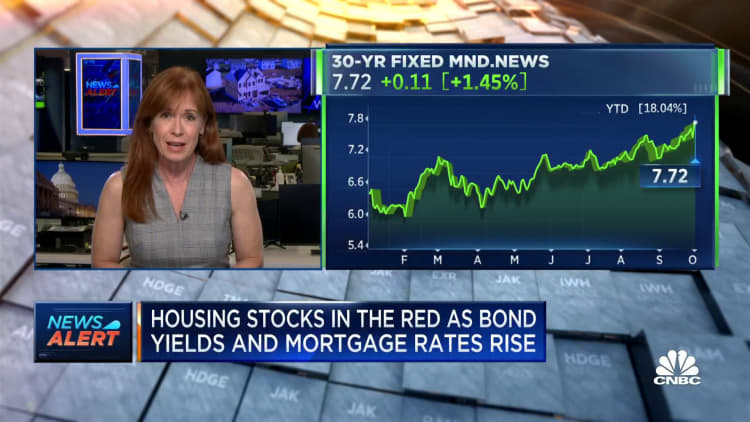Federal Reserve Board Chair Jerome Powell speaks during a news conference following a Federal Open Market Committee meeting at the Federal Reserve in Washington, D.C., on July 26, 2023.
SAUL LOEB | Getty
Violent moves in the bond market this week have hammered investors and renewed fears of a recession, as well as concerns about housing, banks and even the fiscal sustainability of the U.S. government.
At the center of the storm is the 10-year Treasury yield, one of the most influential numbers in finance. The yield, which represents borrowing costs for issuers of bonds, has climbed steadily in recent weeks and reached 4.8% on Tuesday, a level last seen just before the 2008 financial crisis.
The relentless rise in borrowing costs has blown past forecasters’ predictions and has Wall Street casting about for explanations. While the Federal Reserve has been raising its benchmark rate for 18 months, that hasn’t impacted longer-dated Treasurys like the 10-year until recently as investors believed rate cuts were likely coming in the near term.
That began to change in July with signs of economic strength defying expectations for a slowdown. It gained speed in recent weeks as Fed officials remained steadfast that interest rates will remain elevated. Some on Wall Street believe that part of the move is technical in nature, sparked by selling from a country or large institutions. Others are fixated on the spiraling U.S. deficit and political dysfunction. Still others are convinced that the Fed has intentionally caused the surge in yields to slow down a too-hot U.S. economy.
“The bond market is telling us that this higher cost of funding is going to be with us for a while,” Bob Michele, global head of fixed income for JPMorgan Chase’s asset management division, said Tuesday in a Zoom interview. “It’s going to stay there because that’s where the Fed wants it. The Fed is slowing you, the consumer, down.”
The ‘everything’ rate
Investors are fixated on the 10-year Treasury yield because of its primacy in global finance.
While shorter-duration Treasurys are more directly moved by Fed policy, the 10-year is influenced by the market and reflects expectations for growth and inflation. It’s the rate that matters most to consumers, corporations and governments, influencing trillions of dollars in home and auto loans, corporate and municipal bonds, commercial paper, and currencies.
“When the 10-year moves, it affects everything; it’s the most watched benchmark for rates,” said Ben Emons, head of fixed income at NewEdge Wealth. “It impacts anything that’s financing for corporates or people.”
The yield’s recent moves have the stock market on a razor’s edge as some of the expected correlations between asset classes have broken down.
Stocks have sold off since yields began rising in July, giving up much of the year’s gains, but the typical safe haven of U.S. Treasurys has fared even worse. Longer-dated bonds have lost 46% since a March 2020 peak, according to Bloomberg, a precipitous decline for what’s supposed to be one of the safest investments available.
“You have equities falling like it’s a recession, rates climbing like growth has no bounds, gold selling off like inflation is dead,” said Benjamin Dunn, a former hedge fund chief risk officer who now runs consultancy Alpha Theory Advisors. “None of it makes sense.”‘
Borrowers squeezed
But beyond investors, the impact on most Americans is yet to come, especially if rates continue their climb.
That’s because the rise in long-term yields is helping the Fed in its fight against inflation. By tightening financial conditions and lowering asset prices, demand should ease as more Americans cut back on spending or lose their jobs. Credit card borrowing has increased as consumers spend down their excess savings, and delinquencies are at their highest since the Covid pandemic began
“People have to borrow at a much higher rate than they would have a month ago, two months ago, six months ago,” said Lindsay Rosner, head of multi sector investing at Goldman Sachs asset and wealth management.
“Unfortunately, I do think there has to be some pain for the average American now,” she said.
Retailers, banks and real estate

Beyond the consumer, that could be felt as employers pull back from what has been a strong economy. Companies that can only issue debt in the high-yield market, which includes many retail employers, will confront sharply higher borrowing costs. Higher rates squeeze the housing industry and push commercial real estate closer to default.
“For anyone with debt coming due, this is a rate shock,” said Peter Boockvar of Bleakley Financial Group. “Any real estate person who has a loan coming due, any business whose floating rate loan is due, this is tough.”
The spike in yields also adds pressure to regional banks holding bonds that have fallen in value, one of the key factors in the failures of Silicon Valley Bank and First Republic. While analysts don’t expect more banks to collapse, the industry has been seeking to offload assets and has already pulled back on lending.
“We are now 100 basis points higher in yield” than in March, Rosner said. “So if banks haven’t fixed their issues since then, the problem is only worse, because rates are only higher.”
5% and beyond?
The rise in the 10-year has halted in the past two trading sessions this week. The rate was 4.71% on Thursday ahead of a key jobs report Friday. But after piercing through previous resistance levels, many expect that yields can climb higher, since the factors believed to be driving yields are still in place.
That has raised fears that the U.S. could face a debt crisis where higher rates and spiraling deficits become entrenched, a concern boosted by the possibility of a government shutdown next month.
“There are real concerns of ‘Are we operating at a debt-to-GDP level that is untenable?'” Rosner said.
Since the Fed began raising rates last year, there have been two episodes of financial turmoil: the September 2022 collapse in the U.K.’s government bonds and the March U.S. regional banking crisis.
Another move higher in the 10-year yield from here would heighten the chances something else breaks and makes recession much more likely, JPMorgan’s Michele said.
“If we get over 5% in the long end, this is legitimately another rate shock,” Michele said. “At that point, you have to keep your eyes open for what looks frail.”


